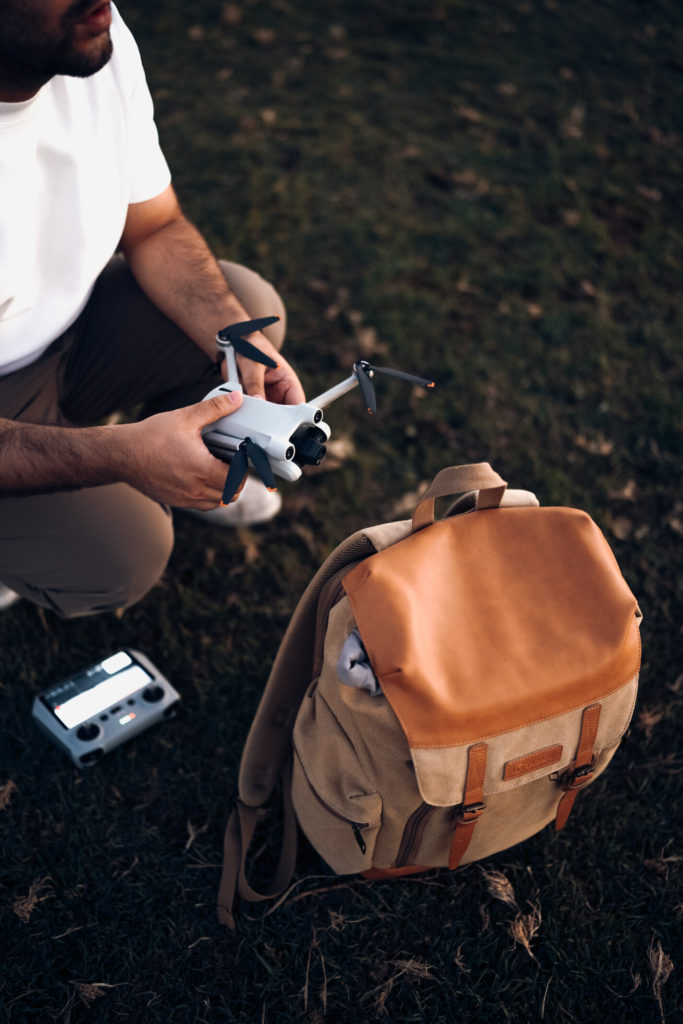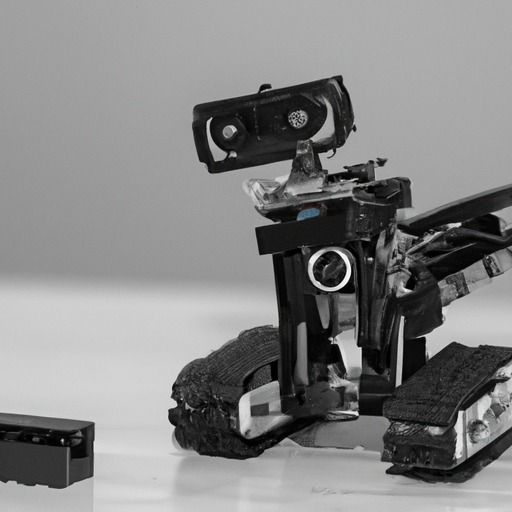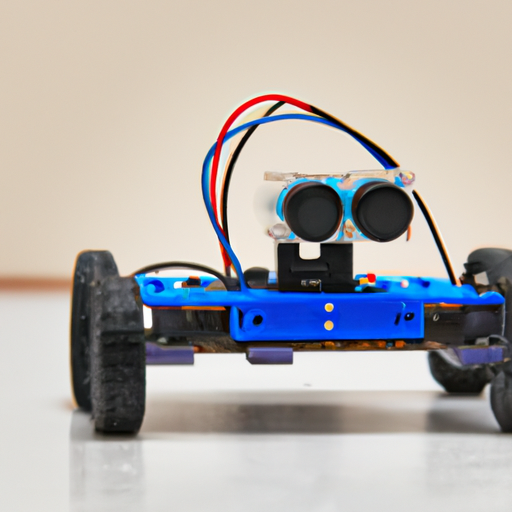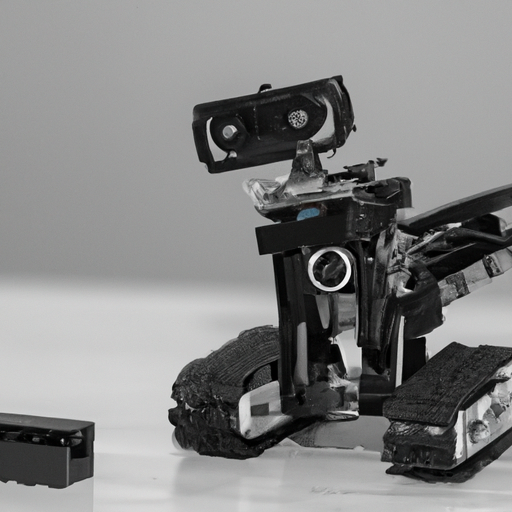Whether you’re a curious beginner or looking to expand your knowledge, “An Introduction to Robotics: Essential Concepts for Beginners” is the perfect resource to kickstart your journey into the fascinating world of robotics. This comprehensive guide offers a user-friendly approach, providing you with a solid foundation of essential concepts that will allow you to understand and appreciate the intricate workings of robots. From the basic principles of programming and mechanics to the exciting potential of artificial intelligence, this article will equip you with the necessary knowledge to explore and experiment with robotics. So grab your curiosity and get ready to embark on an exciting adventure in the realm of robotics!

1. What is Robotics?
Robotics is the field of technology that deals with the design, development, and application of robots. A robot is a mechanical device that is capable of performing tasks automatically or with some level of autonomy. It combines various technologies such as mechanical engineering, electronics, and computer science to create machines that can interact with the environment and perform tasks that were traditionally carried out by humans.
1.1 Definition of Robotics
Robotics can be defined as the branch of technology that involves the creation, programming, and use of robots. A robot is typically a mechanical device that is guided by a computer program or controlled by a human operator. It can be programmed to perform specific tasks, and in some cases, it can even learn from its environment and adapt its behavior accordingly. The main goal of robotics is to develop machines that can perform tasks more efficiently, accurately, and safely than humans.
1.2 Brief History of Robotics
The history of robotics can be traced back to ancient times, where the concept of automatons and mechanical devices was first introduced. Ancient civilizations like the Greeks, Egyptians, and Chinese had devised various mechanical contraptions that demonstrated rudimentary automation.
However, modern robotics as we know it today began to take shape in the 20th century. In 1954, George Devol and Joseph Engelberger developed the first industrial robot, the Unimate, which was capable of performing repetitive tasks on an assembly line. This marked the beginning of the robotic revolution in industries.
Since then, robotics has evolved rapidly, with advancements in technology enabling the development of more sophisticated and capable robots. The introduction of microprocessors, sensors, and artificial intelligence has paved the way for the creation of robots that can perceive and interact with their environment more effectively.
1.3 Importance of Robotics in Various Fields
Robotics has become increasingly important in various fields and has revolutionized many industries. In manufacturing, robots have automated repetitive and dangerous tasks, leading to increased productivity, improved product quality, and reduced costs. They are capable of working tirelessly and consistently, leading to higher efficiency and output.
In the healthcare field, robots are used for tasks such as surgery, rehabilitation, and patient care. They assist doctors and medical professionals in performing complex procedures with precision and accuracy, minimizing the risks associated with human error.
Robotics also plays a crucial role in space exploration, where robots are used to explore and investigate celestial bodies. They can withstand harsh environments and perform tasks that are too dangerous or impractical for humans.
In agriculture, robots have the potential to increase efficiency and productivity. They can be utilized for tasks such as planting, harvesting, and monitoring crop health, reducing the need for manual labor and improving precision.
Education and research are other areas where robotics has made significant contributions. Robotics provides a hands-on and interactive learning experience, enabling students to develop critical thinking, problem-solving, and technical skills. It also serves as a platform for research and innovation, pushing the boundaries of what is possible in robotics technology.
Overall, robotics has the potential to transform various industries and improve the quality of life by automating tasks, increasing efficiency, and enabling new possibilities.
2. Components of a Robot
A robot is comprised of several essential components that work together to enable its functionality. These components include actuators, sensors, power supply, a controller, and end effectors.
2.1 Actuators
Actuators are devices responsible for converting energy into motion. In the context of robotics, they are the mechanisms that allow robots to move and perform tasks. Actuators can be classified into various types, such as electric actuators, hydraulic actuators, and pneumatic actuators.
Electric actuators use electricity to generate motion, and they can be further categorized into motors, such as DC motors and stepper motors. Hydraulic actuators use fluid pressure to produce motion, while pneumatic actuators utilize compressed air.
Actuators play a crucial role in enabling the robot to interact with its environment. They allow the robot to manipulate objects, move its limbs, and perform various actions required for its intended tasks.
2.2 Sensors
Sensors are vital components of a robot that enable it to perceive and gather information about its environment. They provide robots with the ability to sense and respond to changes in their surroundings. Sensors can measure properties such as distance, temperature, pressure, light, and sound, among others.
Some common types of sensors used in robotics include proximity sensors, force sensors, vision sensors, and inertial sensors. Proximity sensors detect the presence of nearby objects, while force sensors measure forces applied to the robot’s end effector. Vision sensors, such as cameras, capture visual information, allowing robots to recognize objects and navigate their surroundings. Inertial sensors, such as accelerometers and gyroscopes, provide information about the robot’s orientation and motion.
By utilizing various sensors, robots can gather real-time data about the environment, enabling them to make informed decisions and adapt their behavior accordingly.
2.3 Power Supply
A reliable power supply is essential for the proper functioning of a robot. Robots require electrical energy to operate their actuators, sensors, and other components. The power supply can be in the form of batteries, fuel cells, or direct power from an external source.
The choice of power supply depends on the specific requirements of the robot and its intended application. For mobile robots, such as drones or autonomous vehicles, batteries are commonly used to provide portability and flexibility. In industrial settings, robots are often powered by direct electrical power provided through a power cable.
Efficient power management is crucial to ensure the long-lasting operation of a robot and to minimize downtime.
2.4 Controller
The controller is the brain of a robot, responsible for controlling its behavior and executing tasks. It receives input from the sensors, processes the information, and sends commands to the actuators. It can be a standalone computer or a microcontroller integrated into the robot’s hardware.
The controller typically runs software that contains algorithms and instructions for performing various tasks. It can be programmed to operate in different modes, allowing the robot to be controlled manually by a human operator or to operate autonomously, making decisions based on pre-programmed logic or real-time data.
The controller is a critical component that determines the intelligence and autonomy of a robot. It enables the robot to interpret sensor data, plan actions, and execute tasks efficiently and accurately.
2.5 End Effectors
End effectors are the tools or devices attached to the robot’s arm or manipulator that enable it to interact with the environment. They can take various forms depending on the specific application of the robot.
For example, in industrial robots, end effectors can be grippers, welding tools, or assembly tools. In medical robotics, end effectors can be surgical instruments or prosthetic limbs. In agricultural robots, end effectors can be mechanisms for planting, harvesting, or spraying crops.
End effectors are designed to perform specific tasks based on the robot’s application. They are often modular and interchangeable, allowing robots to be versatile and adapt to different tasks and environments.
The choice of end effector depends on the requirements of the robot’s intended tasks, and it plays a crucial role in enabling the robot to manipulate objects and perform actions in its environment.

3. Types of Robots
Robots can be classified into various types based on their intended applications and capabilities. Each type of robot serves a specific purpose and is designed to perform tasks in different environments and industries.
3.1 Industrial Robots
Industrial robots are specifically designed for manufacturing and industrial automation. They are used in various industries, including automotive, electronics, and food processing. Industrial robots are capable of performing tasks such as assembly, welding, painting, and material handling.
These robots are typically large, heavy-duty machines that operate in controlled environments, such as factories or production lines. They are programmed to work autonomously and can perform repetitive tasks with high precision and speed.
Industrial robots improve efficiency, productivity, and product quality in industries by reducing human error, enabling continuous operation, and handling heavy or hazardous materials.
3.2 Service Robots
Service robots are designed to assist humans in performing everyday tasks and providing various services. They are used in environments such as homes, hospitals, hotels, and public spaces. Service robots can perform tasks such as cleaning, customer service, security, and entertainment.
These robots are typically smaller and more compact than industrial robots, making them suitable for indoor environments and human interaction. They are often equipped with sensors and artificial intelligence capabilities to navigate and interact with their surroundings.
Service robots enhance convenience, safety, and comfort in various settings by automating tasks and providing assistance to humans in their daily lives.
3.3 Medical Robots
Medical robots are robots used in healthcare and medical applications. They are designed to assist doctors, surgeons, and medical professionals in performing procedures, diagnosis, and therapeutic tasks. Medical robots can be used for tasks such as surgery, rehabilitation, telemedicine, and patient care.
These robots are highly specialized and have stringent safety and accuracy requirements. They are often equipped with advanced sensing and imaging technologies to assist in precise procedures and provide real-time feedback to medical professionals.
Medical robots improve the precision and accuracy of medical procedures, reduce the invasiveness of surgeries, and enhance patient outcomes.
3.4 Autonomous Robots
Autonomous robots are robots that can operate and make decisions without human intervention. They are equipped with artificial intelligence and sensing capabilities, allowing them to perceive and interpret their environment and navigate autonomously. Autonomous robots can be used in various applications such as transportation, exploration, and surveillance.
These robots are designed to operate in dynamic and unstructured environments, adapting their behavior to changing conditions. They can make decisions based on pre-programmed rules, machine learning algorithms, or a combination of both.
Autonomous robots enable tasks to be performed in situations where human presence or intervention is impractical, dangerous, or inefficient.
3.5 Collaborative Robots
Collaborative robots, also known as cobots, are designed to work alongside humans in a collaborative manner. They are designed to be safe and interact with humans without causing harm. Collaborative robots can be used in various applications, such as assembly, material handling, and quality control.
These robots are equipped with advanced sensors and safety features that allow them to detect and respond to human presence, ensuring safe interactions. Collaborative robots are designed to be lightweight, easy to program, and flexible, allowing them to work in close proximity to humans.
Collaborative robots improve productivity and efficiency by combining the strengths of humans and robots, enabling tasks to be performed collaboratively and safely.
4. Robotic Systems
Robotic systems consist of various components and technologies that enable the operation and functionality of robots. These systems include teleoperation versus autonomous robots, perception and sensing, planning and control, robot communication, and human-robot interaction.
4.1 Teleoperation vs. Autonomous Robots
Teleoperation refers to the control of a robot by a human operator. In teleoperation, the human operator uses input devices, such as joysticks or haptic interfaces, to control the robot’s movements or actions.
Autonomous robots, on the other hand, do not require continuous human intervention and can operate independently. They use pre-programmed instructions, artificial intelligence algorithms, or sensor data to make decisions and adapt their behavior to the environment.
Both teleoperation and autonomous robots have their advantages and limitations. Teleoperation allows for human expertise and decision-making in complex situations, while autonomous robots offer the advantage of continuous operation without human supervision.
4.2 Perception and Sensing
Perception and sensing are crucial for robotic systems to gather information about the environment and make informed decisions. Perception refers to the ability of a robot to sense and understand its surroundings through sensors and algorithms.
Sensing involves the use of various sensors to measure and detect properties such as distance, temperature, pressure, and visual information. Sensors provide data that helps the robot perceive and interpret its environment. This information is essential for tasks such as object recognition, navigation, and obstacle avoidance.
Advancements in perception and sensing technologies, such as computer vision, lidar, and radar, have enabled robots to interact more effectively with their environment and perform complex tasks with higher accuracy.
4.3 Planning and Control
Planning and control are key components of robotic systems that enable robots to execute tasks efficiently and accurately. Planning involves generating a sequence of actions or a path that the robot needs to follow to achieve a specific goal. It involves algorithms and decision-making processes that take into account the robot’s capabilities, environment, and desired outcome.
Control involves the execution of the planned actions or motion. It ensures that the robot moves and performs tasks precisely and safely. Control algorithms, such as feedback control or motion planning, are used to manage and adjust the robot’s movements in real-time based on sensory feedback.
Planning and control algorithms are critical for the successful operation of robots, allowing them to navigate complex environments, perform tasks with precision, and adapt their behavior as needed.
4.4 Robot Communication
Robot communication refers to the exchange of information and instructions between robots or between robots and humans. Communication is essential for coordination, collaboration, and control of robots in multi-robot systems or human-robot interaction scenarios.
Communication can occur through various means, such as wireless networks, wired connections, or through the internet. Robots can communicate with each other using protocols and standards designed specifically for robotic systems.
Effective communication enables robots to collaborate, share information, and coordinate their actions, leading to increased efficiency and performance in tasks that require teamwork or coordination.
4.5 Human-Robot Interaction
Human-robot interaction focuses on the interaction between humans and robots and the design of interfaces that facilitate effective communication and collaboration. Human-robot interaction can occur through various modalities, such as touch, speech, gestures, or facial expressions.
Designing intuitive and user-friendly interfaces is essential to enable humans to interact and control robots effectively. Human-robot interaction research explores areas such as natural language processing, gesture recognition, and emotion recognition to enhance the interaction experience.
In applications where humans and robots work side by side, ensuring safe and intuitive interaction is crucial to prevent accidents or misunderstandings and to promote trust and cooperation.

5. Robot Programming
Robot programming involves creating instructions and algorithms that enable robots to perform specific tasks. Programming robots requires knowledge of programming languages for robots, robot simulation, algorithm design for robot control, and robot vision and perception.
5.1 Programming Languages for Robots
Programming languages for robots are specialized languages that allow programmers to control and interact with robots. These languages provide features and libraries specifically designed for robotics applications.
Some common programming languages for robots include:
- Robot Operating System (ROS): ROS is a flexible framework for writing robot software. It provides a set of libraries and tools that allow developers to create complex robot applications.
- Python: Python is a versatile programming language that is widely used in robotics. It offers a simple syntax and a large ecosystem of libraries for various robotic tasks.
- C++: C++ is a low-level language commonly used for performance-critical applications in robotics. It provides control over memory and hardware resources and is suitable for tasks such as real-time control and sensor data processing.
- MATLAB: MATLAB is a high-level programming language commonly used for scientific and engineering applications, including robotics. It provides a rich set of mathematical and simulation tools for robot programming.
The choice of programming language depends on the specific requirements of the robot and the task at hand. Each language has its advantages and limitations, and the selection should be based on factors such as performance, ease of use, and availability of libraries and resources.
5.2 Robot Simulation
Robot simulation involves creating virtual models of robots and their environments to test and validate algorithms and control strategies before deploying them on real robots. Simulation enables developers to evaluate the performance, behavior, and efficiency of robots without the need for physical prototypes.
Simulation tools provide a virtual environment where the robot’s behavior can be visualized and modified. They allow for the testing of different scenarios and conditions, providing insights into the robot’s capabilities and limitations.
Robot simulation can also be used for training purposes, allowing operators or programmers to practice and refine their skills in a safe and controlled environment.
Simulation plays a vital role in reducing development time and cost by identifying and resolving issues early in the design process, leading to more robust and efficient robot systems.
5.3 Algorithm Design for Robot Control
Algorithm design for robot control involves creating algorithms that enable robots to perform tasks autonomously or under human supervision. Robot control algorithms determine how the robot perceives its environment, plans its actions, and executes tasks.
Control algorithms can be classified into different categories, such as feedback control, motion planning, and machine learning. Feedback control algorithms use sensor feedback to adjust the robot’s movements in real-time, ensuring precise and stable behavior.
Motion planning algorithms generate a path or sequence of actions that the robot needs to follow to reach its goal while avoiding obstacles and constraints. These algorithms take into account the robot’s dynamics, sensor data, and environment information.
Machine learning algorithms allow robots to learn from data and adapt their behavior based on experience. They can be used for tasks such as object recognition, pattern recognition, and decision-making.
Designing efficient and reliable control algorithms is essential for ensuring the accuracy and safety of the robot’s actions and enabling it to perform tasks effectively.
5.4 Robot Vision and Perception
Robot vision and perception involve the use of sensors and algorithms to enable robots to perceive and understand their environment visually. Vision is one of the most important senses for a robot as it provides valuable information for various tasks such as object recognition, localization, and navigation.
Robot vision involves the use of cameras or other imaging sensors to capture visual information. This information is then processed using computer vision algorithms to extract relevant features, recognize objects, and understand the robot’s surroundings.
Perception is not limited to vision alone. It can involve other sensory modalities, such as touch or sound, to gather information about the environment.
Advancements in computer vision and sensing technologies have led to significant improvements in robot perception, enabling robots to interact with the environment more effectively, navigate complex terrains, and perform tasks with higher accuracy.
6. Robot Applications
Robots have a wide range of applications across various industries and fields. Some of the key areas where robots are extensively used include manufacturing and industrial automation, healthcare and medical applications, exploration and space robotics, agriculture and farming, and education and research.
6.1 Manufacturing and Industrial Automation
Industrial robots have revolutionized the manufacturing industry by automating repetitive and labor-intensive tasks. They are used in tasks such as assembly, welding, painting, and material handling. Industrial robots can operate continuously and precisely, leading to increased productivity, improved product quality, and reduced costs.
6.2 Healthcare and Medical Applications
Robots are increasingly being used in healthcare and medical applications to assist doctors and medical professionals. They are used in surgeries to enhance precision and minimally invasive procedures, reducing the risk of complications and improving patient outcomes. Robots are also used in rehabilitation to assist patients in regaining motor skills and mobility. Additionally, robots are used for tasks such as telemedicine, patient care, and drug administration.
6.3 Exploration and Space Robotics
Robots are used in space exploration for tasks that are too dangerous, remote, or impractical for humans. Space robots perform tasks such as collecting samples, analyzing the environment, and assisting in the assembly and maintenance of spacecraft and space stations. They are designed to withstand harsh conditions and to operate autonomously or under remote control.
6.4 Agriculture and Farming
Agricultural robots, also known as agrobots or agri-robots, are used in farming and agriculture to automate tasks such as planting, harvesting, and monitoring crop health. Agricultural robots can increase efficiency, reduce labor costs, and minimize the use of chemicals or pesticides. They can perform tasks in a precise and targeted manner, leading to improved crop yields and resource management.
6.5 Education and Research
Robots play a vital role in education and research by providing a platform for hands-on learning and experimentation. Educational robots are designed to be user-friendly and are used to teach programming, problem-solving, and critical thinking skills to students. Research robots are used by scientists and researchers to explore new capabilities, push the boundaries of robotics, and innovate in various fields.
Robot applications are vast and continue to grow as technology advances. The potential for robotics in various industries and fields is immense, promising improved efficiency, safety, and quality of life.

7. Ethical and Social Implications of Robotics
The rapid advancements in robotics technology raise ethical and social implications that need to be carefully considered. As robots become more capable and integrated into our daily lives, there are concerns regarding job displacement, privacy and security, ethical considerations in robot behavior, and the human-robot relationship.
7.1 Job Displacement
One of the main concerns surrounding robotics is the potential displacement of human workers. As robots become more advanced, there is a fear that they may replace humans in various industries, leading to unemployment and economic inequality. It is important to strike a balance between automation and the preservation of job opportunities for humans. Additionally, there is a need for retraining and upskilling programs to ensure that workers can adapt to the changing job market.
7.2 Privacy and Security
Robots are equipped with sensors and capabilities that allow them to collect and store data, which may include personal or sensitive information. There are concerns about the privacy and security of this data, as well as the potential for misuse or unauthorized access. It is crucial to establish regulations and safeguards to protect the privacy and security of individuals and ensure responsible handling of data by robotics companies and organizations.
7.3 Ethical Considerations in Robot Behavior
As robots become more autonomous and capable of making decisions, there is a need to consider ethical considerations in their behavior. Robots may be required to make ethical decisions in certain situations, such as in medical settings or autonomous vehicles. It is essential to develop ethical frameworks and guidelines to ensure that robots make decisions that align with human values and moral principles.
7.4 Human-Robot Relationship
The interaction between humans and robots raises questions about the nature of the human-robot relationship. As robots become more sophisticated and human-like, there is a potential for emotional attachment or dependence on robots. It is important to foster a healthy and responsible human-robot relationship, ensuring that robots complement human capabilities and enhance human well-being without adversely affecting social interactions and relationships.
Addressing these ethical and social implications is crucial in ensuring the responsible development and deployment of robotics technology. A multidisciplinary approach involving experts from various fields, including robotics, ethics, sociology, and law, is required to navigate the challenges and implement policies that promote the responsible and beneficial use of robots in society.
8. Challenges in Robotics
The field of robotics faces several challenges that need to be addressed to advance the development and deployment of robots. These challenges include perception and sensing, robot manipulation and dexterity, navigation and path planning, and machine learning and artificial intelligence.
8.1 Perception and Sensing Challenges
Perception and sensing are crucial for robots to understand and interact with their environment. However, challenges exist in developing robust and accurate perception systems that can handle diverse and complex environments. Sensor technologies need to be more reliable, and algorithms need to be more efficient in processing and interpreting sensor data. Overcoming these challenges will enable robots to perceive and understand their surroundings more effectively.
8.2 Robot Manipulation and Dexterity
Robot manipulation and dexterity refer to the ability of robots to manipulate objects and perform precise and complex tasks. Achieving human-level dexterity and agility is a challenge due to the complexity and variability of objects and environments. Improvements in actuation systems, robot control algorithms, and robotic hands and end effectors are necessary to enhance the manipulation capabilities of robots.
8.3 Navigation and Path Planning
Navigation and path planning involve enabling robots to move and maneuver in complex environments. Challenges exist in developing algorithms that can handle dynamic and unstructured environments while ensuring safe and efficient navigation. Robot systems need to be able to perceive and interpret their surroundings accurately, plan trajectories that avoid obstacles and collisions, and adapt their behavior in real-time.
8.4 Machine Learning and Artificial Intelligence
Machine learning and artificial intelligence are key technologies used in robotics to enable robots to learn and adapt to their environment. Challenges exist in developing machine learning algorithms that can handle large and diverse datasets, ensure generalization across different scenarios, and make sound decisions based on incomplete or noisy data. Ethical considerations also arise in ensuring that robots make fair and unbiased decisions.
Addressing these challenges requires continued research and development in various areas of robotics, such as perception, control, planning, and learning. Collaboration between academia, industry, and government organizations is necessary to overcome these challenges and advance the field of robotics.

9. Future of Robotics
The future of robotics holds great promise in terms of advancements in technology and integration with other emerging fields. Some key areas that are expected to shape the future of robotics include advancements in robotics technology, integration of robots with artificial intelligence (AI) and the Internet of Things (IoT), possibilities in humanoid robots, and the impact on society and everyday life.
9.1 Advancements in Robotics Technology
Advancements in robotics technology are expected to continue at a rapid pace. The development of more advanced and efficient actuators, sensors, and control systems will enable robots to perform tasks with higher precision, speed, and autonomy. Miniaturization of components will lead to more compact and portable robots, expanding their potential applications.
9.2 Integration of Robots with AI and IoT
The integration of robots with artificial intelligence (AI) and the Internet of Things (IoT) will lead to more intelligent and connected robotic systems. AI algorithms will enable robots to learn from data, make informed decisions, and adapt their behavior based on real-time feedback. Integration with IoT will allow robots to communicate and share data with other devices and systems, enabling seamless collaboration and coordination.
9.3 Possibilities in Humanoid Robots
Humanoid robots, which resemble human beings in appearance and behavior, represent an exciting area of robotics research. Advancements in materials, actuators, and artificial muscles will enable the development of more realistic and capable humanoid robots. Humanoid robots have the potential to assist humans in a variety of tasks, such as caregiving, personal assistance, and entertainment.
9.4 Impact on Society and Everyday Life
The rapid advancement and integration of robotics technology will have a significant impact on society and everyday life. Automation and robotics will continue to transform industries, leading to changes in the job market and the nature of work. Robots will increasingly become a part of households, assisting with chores, providing companionship, and contributing to a more convenient and comfortable lifestyle.
However, the widespread adoption of robotics also raises important societal considerations, such as ethical and legal implications, job displacement, and the need for retraining and reskilling programs. There is a need for thoughtful and responsible implementation of robotics technology to ensure its positive impact on society.
10. Resources for Learning Robotics
Learning robotics requires a multidisciplinary approach and a combination of theoretical knowledge and practical skills. Various resources are available to help individuals learn and get started in robotics.
10.1 Books and Publications
Books and publications provide in-depth knowledge and insights into various aspects of robotics. Some recommended books for beginners include:
- “Introduction to Robotics: Mechanics and Control” by John J. Craig
- “Robotics: Modelling, Planning and Control” by Bruno Siciliano and Lorenzo Sciavicco
- “Robotics, Vision and Control: Fundamental Algorithms in MATLAB” by Peter Corke
In addition to books, scientific journals and conference proceedings publish the latest research and developments in robotics. Reading academic papers can provide a deeper understanding of specific topics and emerging trends in robotics.
10.2 Online Platforms and Courses
Online platforms and courses offer interactive learning experiences and provide access to educational resources and tools. Some popular online platforms for learning robotics include:
- Coursera: Coursera offers a variety of robotics courses, including introductory courses and advanced topics. These courses are taught by leading experts in the field and are suitable for learners of all levels.
- edX: edX offers robotics courses from top universities and institutions. These courses cover a range of topics, from introductory concepts to advanced robotics algorithms. edX also provides hands-on exercises and projects to apply the learned concepts.
- ROS.org: ROS (Robot Operating System) is a widely-used framework for writing robot software. ROS.org provides tutorials, documentation, and resources to learn ROS and develop robotics applications.
10.3 Robotics Competitions and Workshops
Robotics competitions and workshops provide hands-on learning experiences and opportunities to apply robotics knowledge and skills. Participating in competitions allows individuals to work on real-world robotics challenges and collaborate with other participants. Some popular robotics competitions include:
- FIRST Robotics Competition: FIRST Robotics Competition is a global robotics competition for high school students. Teams design, build, and program robots to compete in various challenges.
- RoboCup: RoboCup is an international robotics competition that focuses on soccer-playing robots. Teams develop autonomous robots that play against each other in simulated or physical soccer matches.
- IEEE Robotics and Automation Society (RAS): IEEE RAS organizes various competitions and workshops focused on robotics and automation. These events provide opportunities for networking, learning, and showcasing robotics projects.
10.4 Professional Organizations and Communities
Professional organizations and communities provide a platform for networking, knowledge sharing, and collaboration in the field of robotics. Some notable organizations and communities include:
- IEEE Robotics and Automation Society: IEEE RAS is a professional society dedicated to advancing the field of robotics and automation. It organizes conferences, publishes journals, and promotes research and education in robotics.
- Robotics Society of America: The Robotics Society of America (RSA) is a nonprofit organization that promotes robotics education and provides resources and support for robotics enthusiasts and professionals.
- Robotics Online: Robotics Online is a community for professionals in the robotics and automation industry. It offers a wealth of resources, including news, articles, job listings, and a community forum for discussions and networking.
By utilizing these resources, individuals can gain the knowledge, skills, and connections necessary to pursue a career or hobby in robotics.
In conclusion, robotics is a fascinating field that combines various technologies to create machines that can perform tasks autonomously or with human guidance. Robots have a wide range of applications in industries, healthcare, exploration, agriculture, and education. The development of robotics technology presents both opportunities and challenges, including ethical considerations, job displacement, and advancements in perception, manipulation, and artificial intelligence. With the right resources and learning opportunities, anyone can explore the world of robotics and contribute to its advancement.

